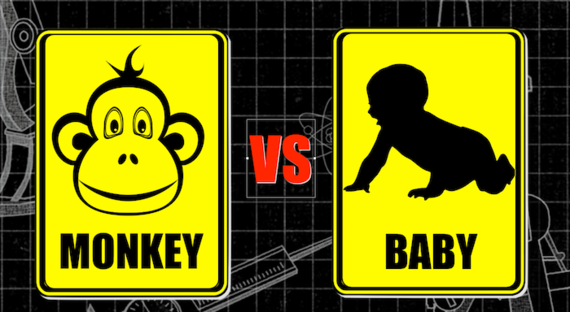On February 15th, 2014, just a few feet from the front door of a residential home occupied by a UCLA scientist, a group of 66 animal rights activists staged a peaceful demonstration. However, "peace" was the opposite of their goal.
But first...
I love monkeys. I love chimpanzees. Bonobos. Orangutans. Gorillas. In fact, I am actually saving my money so I can go see chimps someday in the wild in the Congo.
I've donated money to support Jane Goodall's research and I will see any movie in which the co-star is an actual monkey: Every Which Way But Loose (Clint Eastwood & an orangutan), Gorillas in the Mist (Sigourney Weaver as scientist, Jane Fossey), even Ed, which starred a hilarious primate named "Ed" and a very un-funny monkey named "Matt LeBlanc."
SIX DOGS: During my lifetime, I have been the recipient of friendship, honesty and decency from six wonderful dogs-- Toto, Sonny Boy, Spot, Finster, Daisy and Indy -- a dozen mice, twice as many gerbils -- it's a long story that begins with the guy who sold them to my parents swearing we had two females -- a parakeet named Ravioli and countless fish -- none of whom I've ever named.
My daughter rides horses.
A few years ago, I stopped talking to our neighbor after I saw her kick her dog.
EVIL EYE: And, on several occasions, I have found stray dogs, took them into my home, called the number on their collar and waited for their owners to come pick them up. And when the owner arrived, I looked at them askance, so they would know I disapproved of their carelessness.
Clearly I love animals.
And yet, you know who I love more than animals? People.
People like babies. Children. Mothers. Fathers. Grandmothers. Jews, Catholics, Muslims, Gays, Straight, Transgendered. African American, Caucasian, Asian, Ameri-Asians, Eskimos. Native Americans. Europeans, Africans, South Americans. Tall. Short. Male. Female. People with diabetes, Parkinson's disease, breast cancer and leukemia. The Kiss Army, Dead Heads and yes, even Beliebers. Plus, anyone else who is indicated on the US census form, but I forgot to mention. It doesn't matter to me. I love all people.
Unless you try and sneak into my lane when we're stuck in traffic. I will cut a bitch.
Where was I? Oh yeah...
LOCATION: Suburban street, Westwood, CA. Outside the home of a UCLA scientist.
Inside the home is an American hero who is part of a team of researchers that believes that in their lifetime, will provide the first and only effective treatment for meth addicts, whose numbers are more than 1 million, according to the NIH. Were the wishes of these 66 activists met -- that science stop medical research on animals:
- Childhood leukemia would have gone untreated and thousands of 5 year old kids would die every year.
- People with AIDS would continue to suffer and die.
- Parkinson's patients would shake uncontrollably.
- Polio would remain uncured and the sight of children crippled by the disease wearing crutches like Forrest Gump would be common place .
- Diabetics would die because scientists would have been prevented from experimenting on pigs who produce life saving insulin.
- Thousands more women will die from breast cancer.
The list goes on and on. In fact, nearly every treatment for every disease that science and medicine has found cures or treatments for in the last 75 years owes part of its success to the animals who gave their lives that we humans might live.
Or suffer less.
Here's just one example:
According to the Childhood Cancer Research Group, the survival rate for children under five who had Leukemia in the 1960s was about 33%. Today, that number is near 90%. We have mice to thank for their help in revealing a medical treatment that has saved multiple thousands of children who would no doubt be dead today, had they been born in the 1960s or 70s and gotten Leukemia.
Video from the demonstration in Westwood, CA
I'm not going to tell you the group's name -- if you want to find it, go ahead. Many times over the last number of years, this group has staged demonstrations -- sometimes violent -- at the homes of UCLA scientists who are quite literally saving human lives by the hundreds of thousands every year... and improving the lives of countless millions.
So, what do we have to thank the Scientists at UCLA for? Here's just a few examples:
Breast Cancer:
UCLA studies utilizing mice were the basis for human clinical trials in patients with metastatic breast cancer. This led to the breakthrough breast cancer medication Herceptin, the first cancer-fighting drug to successfully target a specific genetic alteration, thereby limiting side effects such as hair loss and nausea that often accompany conventional therapies. Mouse models of human cancers such as prostate, pancreatic and lung cancer are widely utilized to test innovative cancer-fighting agents.Parkinson's Disease:
UCLA scientists pioneered deep brain stimulation, a surgical procedure used to treat a variety of disabling neurological symptoms -- most commonly the debilitating symptoms of Parkinson's disease, such as tremors, rigidity, stiffness, slowed movement and walking problems. The procedure, made possible through research involving non-human primates, is used to treat Parkinson's patients experiencing only limited benefits from medication alone. Deep brain stimulation also is used to treat essential tremor, a common neurological movement disorder.
Schizophrenia:
Researchers at UCLA have developed new insights into the biochemical processes that contribute to cognitive disabilities affecting behavior, speech and reasoning in schizophrenia patients. Within the prefrontal cortex, a region of the brain especially well-developed in non-human primates, two neurochemicals engage in an intricate balance to coordinate optimal cognition. As research continues, specifying the nature of these interactions holds promise for discovering genes that cause schizophrenia and developing treatments to counteract it. The work also holds promise for treating other neurological and psychiatric disorders, notably Alzheimer's-related dementia, stroke and brain trauma.
You can read the rest of the UCLA medical breakthroughs on their website, HERE.
*As a side note, you should also know that the scientific research done with animals is carefully vetted by a university committee that considers the work's potential value and what, if any suffering, animals may be subjected to and that not all research or experiments are funded.
FEAR & TERROR: On February 15th, 2014, this group of 66 demonstrated peacefully. However, their goal was not peace. Their goal was to intimidate. Their goal was to harass. Their goal was to terrorize.
Even worse, their chants had no word to rhyme with "vivisection." Amateurs!
OK, I know what you're thinking... I said earlier that I have a love for animals. So, you rightly ask, how can I also think it's OK to subject animals to what must be both painful and cruel? Especially the dogs and monkeys I claim to love so much. Clearly, I'm a hypocrite, right?
It's pretty simple, really. Around the time my mother was 25 years old or so, she mysteriously developed chronic kidney failure. Over the course of about the next 8 to 10 years, she went from having 100% kidney effectiveness to kidney's that stopped working entirely.
Then, over the course of the next 32 years or so -- until her death in 1997 -- my mother was on hemo-dialysis three times a week for three hours. In the event you don't know, she was hooked up to a machine via a series of plastic tubes. In her arm were two large needles. Out one of the needles came the dirty blood. The blood flowed through the tubes into a device that cleaned the blood. The clean blood flowed back into her arm and an artery via the second needle.
Thanks to sheep, scientists figured out how to construct and implant a shunt -- a device implanted in my mother's arm which allowed her to connect to a dialysis machine for long term treatment. Sheep allowed me to have a mother.
Thanks to mice and guinea pigs, scientists were able to understand why and how the body rejects transplanted tissue -- my mother had two kidney transplants. Thanks to mice and guinea pigs, I was able to grow up with a mother.
Thanks to mice, scientists were able to perfect the medication, cyclosporin, which effectively prevents the body's own immune system from attacking the foreign tissue -- meaning, the transplanted kidney. Again, thanks to mice, I was able to grow up with a mother.
After all, prior to the 1960s, kidney failure was fatal 100% of the time and were my mother born a few years sooner, rather than growing up with her... I would have grown up with her.
I'd be remiss if I didn't also note that there are dozens of other medications, treatments and procedures that went into managing my mother's care that also had their efficacy tested, demonstrated and perfected on animals.
In closing, I'd like to ask the demonstrators a few questions:
1. Are you aware that thanks to medical experiments done on animals, you are here today -- not dead -- and likely healthy? Why? Because when you were a child, you did not get measles, mumps or rubella. Or polio. Or the plague. All of their vaccines and cures at some point in their creation, were tested on animals.
2. Have you ever gotten a headache? Did you find relief by taking Tylenol? Like all the other medications we take, at one point or another, animal testing was involved in Tylenol's creation and perfection.
3. Do you have a brother or sister, cousin, parent or friend who is addicted to drugs or alcohol? So addicted -- so sad -- so messed up -- so fucked up -- so out of touch -- so so soul crushingly sad -- that you are terrified every time the phone rings after midnight -- because you're certain it's the police with news that someone you love has overdosed and died? Did you know scientists at UCLA are close to figuring out why addicts can't stop? And, that they expect to solve that problem in our lifetime?
4. Do you know anything about the Tuskegee experiments? From the early 1930s through the mid 1970s, America's Public Health Service studied the progression of untreated syphilis on about 600 poor African Americans who thought they were actually getting treatment. Calling the experiments the most shameful acts in the history of American medicine doesn't even come close to describing their horror. Is that what you'd prefer to testing on animals? For emerging treatments to be tested on the poor? The sick? The tired? The ones who are too slow to run away? Is your preference that disease progression to be studied in those too poor to pay for treatment? Too old to live a full life anyway? When you get some ideas that are better than animal testing, please immediately post them on the web. Scientists the world over are anxious to hear them.
5. Do you know that research on animals ALSO improves the lives of other animals, as well?
6. And finally, why are you so determined to deny future generations the cures and treatments for cancer, heart disease, addiction, Alzhiemer's, et al?
Jon Hotchkiss is the creator of This vs That, a new six hour science TV series hailed by NBC News, CNN and the BBC, featuring renown scientists, doctors and researchers from America's most respected institutions, including: Fermi Lab, UCLA, and Cedar's Sinai.


